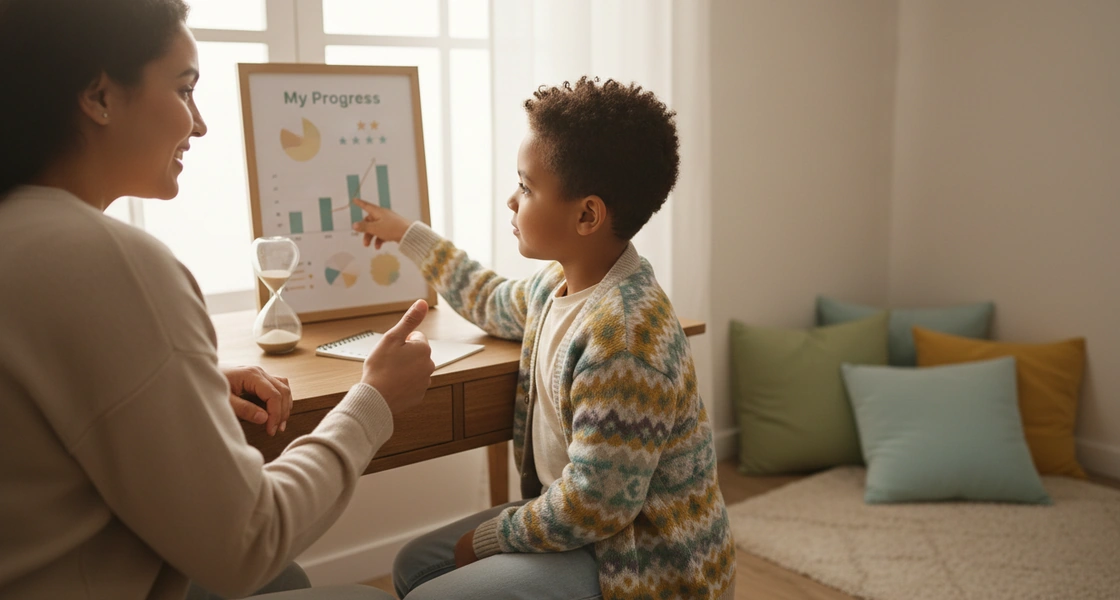Recognizing and creating rhyming words is a big step in helping learners to grow as readers. Rhyming builds the foundation for reading fluency and understanding. When learners start to notice the musical patterns in words like "cat" and "hat" or "moon" and "spoon", they're developing phonemic awareness, one of the key skills that leads to strong, confident reading.
When you start teaching rhyming words, you open up a world of joyful moments, from silly songs to interactive games that make learning fun. Small interactive classes, such as a rhyming adventures class, can help turn these concepts into lively experiences that fit easily into your family's routine. Our experienced teachers make every lesson engaging while guiding your learners to grow and gain confidence at their own pace.
The importance of rhyming in early literacy
Understanding why rhyming matters in early literacy starts with noticing how your child naturally connects with sound patterns. These early connections lay the groundwork for phonological awareness, a key skill for future reading success. As your child begins to recognize and play with rhyming words, they build phonemic awareness, one of the core building blocks for strong reading fluency and comprehension.
When your child learns to hear and match sounds through rhyming, they build a strong foundation for reading and spelling. You'll see their confidence grow as they easily recognize word patterns and predict rhyming pairs. In interactive classes like Fun and Engaging Reading Tutoring, they explore these skills in a playful, supportive setting, turning learning into a fun adventure.
Musical elements add another dimension to rhyme learning. Combining melody and rhyme creates memorable patterns that help your child retain new vocabulary. Learners will begin incorporating rhyming words from songs into their daily conversations, showing how naturally they absorb language through musical play.
How rhyming words enhance language development
Parents and educators often wonder how rhyming words help language development in their little ones. The moment it starts to click is when children start noticing sound patterns, like realizing "cat," "hat," and "mat" share a special connection. Spotting these patterns is a big step towards becoming a reader. It builds their confidence and sets the stage for strong reading skills later. You may notice your child starting to make these connections during bedtime stories or while singing along to favorite songs.
Children light up when playing with rhyming words, and there's an excellent reason for this. Learners who engage with nursery rhymes and word play build powerful memory skills that naturally help them learn new words.
Young readers start to blossom when they practice rhyming, especially in fun and interactive settings like a beat box rhyming class or a phonological awareness workshop. When learners read rhyming stories, they begin to guess what comes next, which boosts their confidence and helps them read more fluently. They enjoy a story and develop reading skills to serve them throughout their learning journey.
Best activities for teaching rhyming words at home
These engaging activities transform moments into rhyming adventures with these engaging activities. Parents find these hands-on approaches particularly effective for teaching rhyming words, as interactive learning strengthens phonological awareness.
Interactive Play (Ages 3-5)
- Create an "I Spy" rhyming adventure during daily routines, perfect for car rides or grocery trips. Start with simple pairs like "I spy something that rhymes with cat" and watch your child's excitement grow as they discover a hat, mat, or bat.
- Use puppet play to introduce rhyming dialogues. Let your learner “talk” through a puppet that only responds in rhyme, to encourage creative thinking and active listening.
- Set up a rhyme time playdate where learners take turns tossing a ball while saying rhyming words aloud. Each catch prompts a new rhyme and social learning.
Movement-Based Activities (Ages 3-6)
- Organize a rhyming treasure hunt by hiding pairs of objects around your home (sock/rock, bear/chair). Turn clue-giving into a playful game of rhyming riddles.
Sensory and Tactile Play (Ages 3-6)
- Use textured materials like playdough or sand to form letters and rhyming word pairs, enhancing multisensory engagement.
- Encourage children to shape rhyming objects (e.g., log and dog) while saying the words aloud.
Visual Learning (Ages 4-7)
- Build a colorful rhyming word wall using sticky notes in your child's favorite colors. Position it at eye level and challenge them to add new rhyming discoveries throughout the week.
- Design rhyming picture cards using magazine cutouts or family drawings. Sort them into rhyming families or play matching games to reinforce word patterns.
- Create a rhyming flipbook where each page ends with the same sound (e.g., -at, -og). Encourage your learner to illustrate and label each word.
Story and Song (Ages 4-8)
- Animated reading of rhyming books creates an interactive learning environment. Pause strategically to let your child predict upcoming rhymes, building confidence and comprehension.
Creative Expression (Ages 5-9)
- Invite your child to write short rhyming poems or silly rhyming songs. Let them illustrate their creations to deepen comprehension and personal connection to the words.
- Dramatic play, such as performing a rhyming skit or improvising a rhyming dialogue between toys, helps reinforce language in a fun and expressive way.
Learners develop at different speeds; some dive into rhyming games early while others take more time. The age ranges listed for each activity are flexible starting points, not strict guidelines. Listening to each learner's interests and adjusting the activities to match their pace helps keep learning enjoyable. When rhyming is fun and playful, it becomes a natural part of everyday moments and supports early reading skills.
Tips for supporting learners in rhyming
Every learner progresses with rhyming at their own pace, and there are many ways to support their unique journey. Exploring different teaching approaches that match your child's learning style can significantly improve both teaching and learning. Here are a few ways you can support your learner if they feel stuck:
- Make use of colorful picture cards showing simple rhyming pairs, such as sun-fun or cat-hat, to build visual connections and boost memory retention.
- Keep practice sessions short and sweet with 10-minute activities focused on two or three word pairs, celebrating each small victory.
- Transform daily activities into rhyming adventures, spot rhyming objects during walks, create silly rhyming stories at dinner, or play word pattern games during car rides.
- Tap into your child's favorite interests to spark engagement. For example, practice with dinosaur names for young paleontologists or superhero words for comic book fans.
- Celebrate learning by spotlighting progress and approaching mistakes as stepping stones to success.
Rhyming and reading: answers for curious educators
Rhyming plays a significant role in early language and reading development and often sparks parents' curiosity. This section dives into some of the most common questions about rhyming, like how it helps with speech, learning differences, and getting started at home, so you can feel confident bringing rhyme into your learners’ everyday routine.
At what age should children start learning rhyming?
Learners can recognize rhymes as early as two or three, though formal instruction often begins in preschool or kindergarten. Even simple exposure to rhyming through songs and stories helps to lay the groundwork early on.
How do I know if my child is ready to start learning rhyming?
Most learners start picking up on rhymes naturally around ages three to five, but readiness can vary. A promising sign your learner is ready is if they enjoy wordplay or recognize when words sound alike. They're likely ready if they giggle when you say “The frog sat on a log” or try to guess the next word in a rhyming story. Start small, keep it playful, and build from there.
How does rhyming support reading comprehension?
Rhyming helps learners recognize sound patterns and guess how words might end. That pattern recognition makes it easier for them to sound out new words, which naturally boosts their reading speed and understanding over time.
What's the difference between phonemic awareness and phonological awareness?
Phonological awareness is a broader skill that recognizes larger sound units, such as syllables and rhymes. Phonemic awareness is more specific and refers to identifying individual sounds in words. Rhyming sits at the intersection, bridging broad sound awareness to more refined reading skills.
How can educators or parents assess a learner's understanding of rhyming?
You can simplify rhyming assessments by asking learners to find rhyming pairs, develop their own rhyming words, or pick out the word that doesn't belong in a group. Watching how they respond during lessons can also tell you much about how well they pick up on sound patterns.
How can I teach rhyming at home without a curriculum?
You don’t need a formal curriculum to get started; you just need a bit of creativity and a willingness to be playful. Singing silly rhyming songs, reading rhyming books together, or making up rhyming games whilst cooking dinner are perfect opportunities for rhyming fun.
What should I do if a learner struggles with rhyming?
Some learners take longer to grasp rhyming concepts. Using multi-sensory techniques and repeated exposure allows them to connect to familiar vocabulary. For persistent difficulties, consider collaboration with a reading specialist or speech-language pathologist.
Can rhyming help with speech delays or articulation?
Yes, it can! Rhyming gives learners repeated chances to practice sounds in a fun and playful way. When they say words such as “cat”, “hat”, or “bat”, they’re tuning into the sounds that make up words. That sound play can support clearer speech and help with articulation over time. It’s not a substitute for speech therapy, but a great way to reinforce sound awareness at home.
How does rhyming help children with dyslexia or learning differences?
Rhyming builds phonological awareness, a key skill for learning to read, especially for learners with dyslexia or other learning differences. When children learn to hear and play with word sounds, it helps them break down and make sense of written language. Rhyming can also make learning feel less overwhelming as it adds rhythm, repetition, and fun to the mix.
Unlock your child's potential with Outschool
Rhyming isn't just fun; it helps build essential skills like sound awareness and vocabulary, which are key to learning how to read. When your child plays with rhymes, they take significant steps toward becoming strong readers. Your lessons can be personal by tailoring each to your learner's pace and interests, turning every session into a meaningful learning experience.
At Outschool, we celebrate every child’s learning style. Whether your learner thrives through music, movement, visuals, or hands-on play, our interactive rhyming classes are designed to meet them where they are. Join our vibrant learning community where passionate teachers turn every class into an unforgettable learning experience.


.svg)
.svg)







